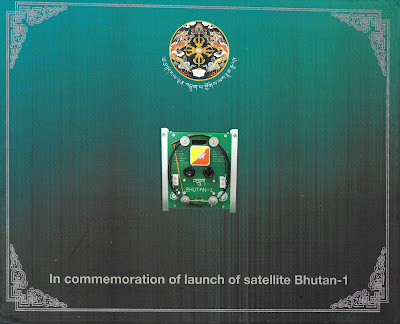2246) BHUTAN - 1, Bhutan: Bhutan Post has brought out a 3D Lenticular set of four stamps of 250 Ngultrum (each) depicting Bhutan's first Satellite (CubeSat) launched into space abroad a Space X Dragon Spacecraft before being deployed from the International Space Station (ISS) into Earth orbit: Date/Year of Stamp set issue: 2018:
BHUTAN-1 was the first Bhutanese nanosatellite to be launched into space:
The "BHUTAN-1" Satellite was built during Kyushu Institute of Technology's "Birds-2 program". The Joint Global Multi Nation Birds Satellite Project called "BIRDS project" is a cross border interdisciplinary satellite project for non space faring countries supported by Japan. The Birds program helps countries fly their first satellite.
"BHUTAN-1" was launched into orbit aboard the "SpaceX CRS-15 mission" on 29.06.2018 from Cape Canaveral Air Force Station in Florida, United States of America. It was deployed from the Kibō module of the International Space Station (ISS) on 10.08.2018.
It was launched on the "SpaceX Falcon 9 rocket" with other payload being sent to the International Space Station (ISS).
The launch took place together with the BIRDS-2 CubeSats of the Philippines and Malaysia - "MAYA-1" and "UiTMST-1". (Five countries participated in the first Birds program (Birds-1).
The four Bhutanese space engineers – Yeshey Choden, Kiran Kumar Pradhan, Cheki Dorji and Pooja Lepcha – pursued a two-year master’s programs in space engineering at the Kyushu Institute of Technology (Kyutech - Japan) and developed the satellite.
The mission finalized for the CubeSat BHUTAN-1 included demonstration of CubeSat’s store and forward ability, i.e. collecting data from remote sensors like weather stations and downloading it to central ground station, Commercial off the Shelf (COTS) GPS technology demonstration with low power to be used in CubeSats and nanosatellites and Single Event Latch-up (SEL) detection to study the radiation effect on satellites are missions finalized for BHUTAN-1.
BHUTAN-1 was designed to take photographs of the homeland via two onboard cameras of 5 Megapixel (MP) and Automatic Packet Reporting System (APRS), receive and send text messages from an amateur radio and broadcast to all other amateur radio within the range. Uplink and downlink operated in 145 Megahertz (MHZ) frequency band.
BHUTAN-1 passed around the country 4-5 times in a day for 3 to 4 minutes during its lifespan of about 6 to 9 months.
A Cube Sat is a miniaturized satellite for space research that is made up of multiples of 10×10×11.35 cm cubic units. Cube Sats have a mass of no more than 1.33 kilograms. The participating countries developed identical CubeSats and Bhutan’s Cubesat it its first satellite.
This was the first time that Bhutan built, launched and operated it’s first space-borne satellite, thus paving the way for Bhutan to move forward in the field of space and satellite technology.
This project also marked Bhutan’s first step towards development of Bhutan’s Space Science and Technology Program.
The Commemorative 3D Stamp set:
The Cover of the Stamp Album shows the emblem of Bhutan at the top, in the centre is a picture of the satellite "BHUTAN-1".
The album is titled "In commemoration of launch of satellite Bhutan-1".
Inner Page 1 gives a brief description of the Bhutan 1 deployment, together with the Technical Details of the stamp Set:
"Bhutan-1 Bhutan's First Satellite: Bhutan has entered into space with the launch of its first satellite, a nano-satellite or cube-satellite (CubeSat), called "BHUTAN-1". The satellite was sent into space at 3.41 PM BST aboard a Space X Dragon Spacecraft, on June 29, 2018 to be delivered to the ISS.
BHUTAN - 1 will be deployed into space from the International Space Station in August 2018.
The satellite has a dimension of (10 x 10 x 10) cubic cm also known as 1 unit or 1U, weighs 1.33 Kg, and is estimated to last 9 months".
The Technical details of Stamp:
Sheet Size: 170.00 mm x 135.00 mm
Stamp Size: 57.60 mm x 40,90 mm
Printing: Offset Lithography
Paper: Lenticulaire 320 gsm
Quantity: 5000 sheets (Unperforated)
Single Sheet of four value stamps
Printer: Cartor Security Printing, BNP Paribas, Evry France
Designer: Tashi Wangchuk & Barun Gurung
An image of the satellite - BHUTAN-1"





Santosh Khanna has commented:
ReplyDelete"Thanks for sharing."
Thank you so much, Khanna sahab.
DeleteVinod Khurana has commented:
ReplyDelete"Very interesting information about our neighborhood."
Thank you for visiting this post, Vinodji.
DeleteRajan Trikha has commented:
ReplyDelete"Very comprehensive information."
Thank you, Trikha sahab.
Delete